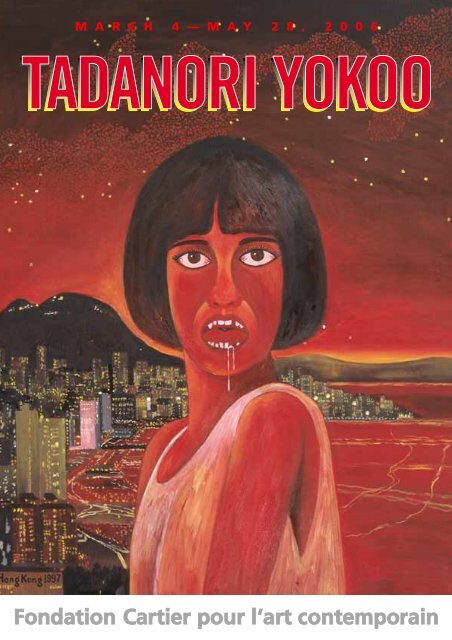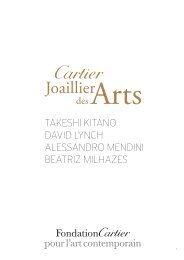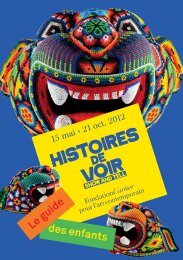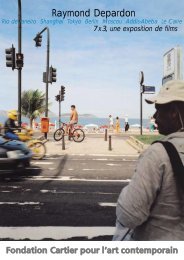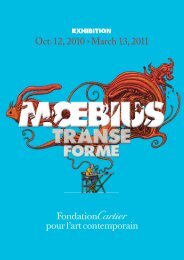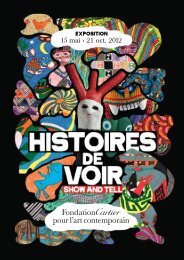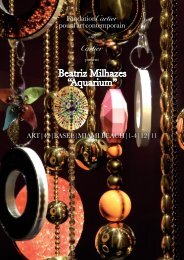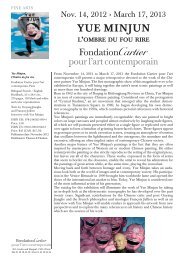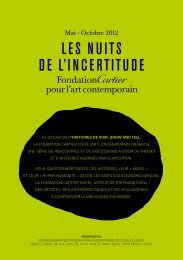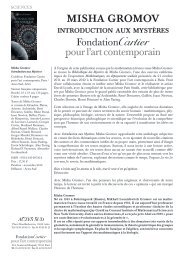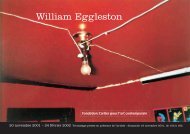DP ANG (PDF) 09/03/06 - Fondation Cartier pour l'art contemporain ...
DP ANG (PDF) 09/03/06 - Fondation Cartier pour l'art contemporain ...
DP ANG (PDF) 09/03/06 - Fondation Cartier pour l'art contemporain ...
Create successful ePaper yourself
Turn your PDF publications into a flip-book with our unique Google optimized e-Paper software.
M A R C H 4 — M A Y 2 8 , 2 0 0 6
TADANORI YOKOO From<br />
20<strong>06</strong> the <strong>Fondation</strong> <strong>Cartier</strong> <strong>pour</strong> l’art <strong>contemporain</strong> is presenting, for the first time outside<br />
of Japan, an exhibition dedicated to the paintings of Japanese artist Tadanori Yokoo. A veritable<br />
graphic design icon in the 60’s and 70’s, Tadanori Yokoo (born in 1936) started his<br />
career in advertising and illustration and soon gained international recognition. Playing<br />
with styles from different periods, he developed an idiosyncratic language, appropriating<br />
elements from the graphic arts tradition in Japanese culture as well as from Western references.<br />
Geishas, rising suns, blond pin-ups, and Hokusai-style waves are some of his favorite<br />
motifs. Through a process of combination and accumulation, he creates a great diversity of<br />
imagery based on repetition and borrowing, pastiching both Eastern and Western art forms<br />
as well as his own compositions.<br />
In 1980, he wrote his “artist’s manifesto”, marking a turning<br />
point in his career. He decided to limit his graphic arts<br />
work in order to devote himself mainly to painting. In his<br />
paintings he explores themes emerging from a personal and<br />
collective memory, such as death, war, society, life, spirituality<br />
and dreams. Yokoo’s works are deeply rooted in the<br />
culture of his native country and reflect the concerns of a<br />
civilization torn between modern development and its<br />
attachment to ancient traditions. In creating a true Pop Art<br />
imagery, Yokoo is able to reveal, better than anyone else,<br />
the culture of post-war Japan.<br />
The paintings exhibited at the <strong>Fondation</strong> <strong>Cartier</strong> were realized<br />
between 1965 and 20<strong>06</strong>. The exhibition presents a<br />
large selection of paintings from Yokoo’s red series. This<br />
color, metaphorically suggestive of Death, seems to obsess<br />
the artist. For Yokoo, “This series of works in red is based on<br />
the observation that there is everyday life in death. Thanks<br />
to the color red, death slowly gains ground in the heart of<br />
life itself, and life and death wind up being as inseparable as<br />
the two sides of a coin.”* Against a starry night, volcanoes,<br />
pyramids and unfinished urban landscapes are deconstructed,<br />
isolated, or accompanied by their reflection, and<br />
admixed with a gush of subjects as astonishing as a skull, a<br />
flying saucer, a lion or a steam engine. In the red series, as<br />
*Interview with Tadanori Yokoo by Takayo Iida.<br />
Excerpt from the exhibition catalog.<br />
March 4 to May 28,<br />
in all of the works in the exhibition, each element’s place in<br />
the composition is the result of the mental associations it<br />
entertains with the others, all of which is entirely dictated by<br />
the artist’s subjectivity: “There is an area in the unconscious<br />
that merges with the conscious mind. If you look at these<br />
two poles outside modern ways of thinking, then it’s true<br />
that the source of my inspiration is subconscious and<br />
archaic.”* Beyond the wide spectrum of colors used by<br />
Yokoo, the extraordinary stylistic diversity of his paintings<br />
attest to an oeuvre which is perpetually reinventing itself.<br />
The large-scale installation consisting of 3,700 postcards<br />
and a painting that covers an entire wall of the exhibition in<br />
a gigantic collage, adheres to the artist’s most cherished<br />
compositional principles: borrowing, pastiching, repeating<br />
an obsessional motif. At the same time, it amplifies the<br />
metaphor of collapse—found throughout his oeuvre—to<br />
unprecedented proportions.<br />
The selection of graphic works exhibited on the mezzanine<br />
gives a brief survey of the illustrations created by Yokoo<br />
between 1965 and 1997. Commissioned by a wide variety<br />
of clients such as museums, theatres, publishers and fashion<br />
designers, they attest to Yokoo’s close ties with artists such<br />
as Yukio Mishima, Issey Miyake and more recently, Naoki<br />
Takizawa.<br />
As part of the Tadanori Yokoo exhibition, young visitors (age 6 and<br />
up) are invited to make their own graphic compositions in postermaking<br />
workshops to be held on Wednesdays, March 29 and<br />
May 3 at 3:00 pm. They may also participate in Wednesday drawing<br />
and painting workshops which will introduce them to Tadanori<br />
Yokoo’s red paintings on April 19 and May 17 at 3:00 pm.
BIOGRAPHY<br />
Tadanori Yokoo was born in 1936 in<br />
Nishiwaki, Japan (Hyogo Prefecture). At<br />
the age of 24, he left to study at the Nippon Design Center<br />
in Tokyo and began working in illustration and advertising.<br />
He was soon remarked by figures like the writer Yukio<br />
Mishima and the fashion designer Issey Miyake, and he<br />
would go on to collaborate closely with them for many<br />
years. Yokoo became involved in the student protest movements<br />
that broke out in the 60‘s, and was an active member<br />
of the new artistic underground scene. He notably designed<br />
posters for the avant-garde theater company Jokyo Gekijo<br />
(“Situation Theatre”) in 1967 and played the leading role<br />
in Nagisa Oshima’s film Diary of a Shinjuku Thief in 1968.<br />
A prolific artist who has worked in a wide variety of disciplines—painting,<br />
graphic design, as well as sets and<br />
costumes for kyogen and kabuki theatre—, Tadanori Yokoo<br />
has become a veritable icon in the Japanese art world. In<br />
1980, he began devoting himself entirely to painting.<br />
Many solo exhibitions have been dedicated to his<br />
graphic arts work in Japan, the United States and Europe. His<br />
exhibition at the <strong>Fondation</strong> <strong>Cartier</strong> <strong>pour</strong> l’art <strong>contemporain</strong> is<br />
the first European exhibition of his paintings. Tadanori Yokoo<br />
is represented by the gallery SCAI the Bathhouse in Tokyo.<br />
EXHIBITION CATALOG<br />
Tadanori Yokoo<br />
Paris: <strong>Fondation</strong> <strong>Cartier</strong> <strong>pour</strong> l’art <strong>contemporain</strong>/<br />
London-New York: Thames & Hudson<br />
Hardback, English version<br />
28 x 22 cm, 156 pages, 120 color reproductions<br />
Photographs of Yokoo by Daido Moriyama<br />
Interview with the artist by Takayo Iida<br />
Text by Jacqueline Lichtenstein<br />
Graphic design: Larry Kazal, Paris<br />
Publication: March, 20<strong>06</strong><br />
Price: 35€<br />
SOLO EXHIBITIONS<br />
20<strong>06</strong> <strong>Fondation</strong> <strong>Cartier</strong> <strong>pour</strong> l’art <strong>contemporain</strong>, Paris<br />
2005 Contemporary Art Museum, Kumamoto<br />
Ikeda Museum of 20th Century Art<br />
The Museum of Modern Art, Toyama<br />
2004 Miyazaki Prefectural Art Museum<br />
20<strong>03</strong> The National Museum of Modern Art, Kyoto<br />
Fukuoka Art Museum<br />
2002 The Museum of Contemporary Art, Tokyo/<br />
Hiroshima City Museum of Contemporary Art<br />
2001 The Museum of Modern Art, Toyama<br />
Hara Museum of Contemporary Art, Tokyo<br />
1997 Hyogo Prefectural Museum of Modern Art, Kobe/<br />
The Museum of Modern Art, Kamakura & Hayama<br />
1995 Tokyo Metropolitan Museum of Photography<br />
1994 Contemporary Art Center, New-Orleans<br />
Park Tower Hall, Tokyo<br />
1987 The Seibu Museum of Art, Tokyo<br />
Carnegie Mellon University, Pittsburgh<br />
1986 Israel Museum, Jerusalem<br />
1985 Kunstlerhause Bethanien, Berlin<br />
1983 Musée de la Publicité, Paris<br />
1982 Museum für Kunst und Gewerbe, Hamburg<br />
1974 Stedelijk Museum, Amsterdam<br />
1973 Museum für Kunst und Gewerbe, Hamburg<br />
1972 The Museum of Modern Art, New York
Upcoming Exhibitions<br />
Zaha Hadid<br />
June 20—October 1st, 20<strong>06</strong><br />
Born in Bagdad in 1950, Zaha Hadid, who lives in London,<br />
became the first woman to be awarded the prestigious<br />
Pritzker Architecture Prize in 2004. A “deconstructivist”<br />
architect whose visionary aesthetics has led her to create<br />
buildings that are complex yet light, moving from the<br />
elongated line to the curve in an interplay of superimposed<br />
planes and vertiginous verticality. For her exhibition<br />
at the <strong>Fondation</strong> <strong>Cartier</strong> she is designing a project specially<br />
for the ground floor of Jean Nouvel’s building.<br />
Agnès Varda, L’ÎLE ET ELLE<br />
June 20—October 1st, 20<strong>06</strong><br />
Agnès Varda has been making films since 1954. She is<br />
most notably the director of Cleo from 5 to 7, Vagabond,<br />
Jacquot, The Gleaners & I. Since Patatutopia, the triple<br />
video installation she presented at the Venice Biennale in<br />
20<strong>03</strong>, and an exhibition at the Aboucaya Gallery in Paris in<br />
2005, she has decided to challenge herself as a filmmaker<br />
by trying out new configurations. The <strong>Fondation</strong> <strong>Cartier</strong><br />
<strong>pour</strong> l’art <strong>contemporain</strong> has invited Agnès Varda to take<br />
over its underground floor for an exhibition to include<br />
installations specially created, for the most part, for the<br />
occasion. The point of departure for all of them will be the<br />
Île de Noirmoutier, an island she regularly returns to.<br />
Between the reality of the inhabitants and her personal<br />
reveries, she will draw her own island.<br />
Practical Information<br />
Exhibition Abroad<br />
The Collection<br />
of the <strong>Fondation</strong> <strong>Cartier</strong><br />
<strong>pour</strong> l’art <strong>contemporain</strong><br />
in Tokyo<br />
April 22—July 2, 20<strong>06</strong><br />
Press opening on Thursday, April 20, 20<strong>06</strong><br />
La <strong>Fondation</strong> <strong>Cartier</strong> <strong>pour</strong> l’art <strong>contemporain</strong> will be showing<br />
major works from its collection at the MOT (Museum<br />
of Contemporary Art) in Tokyo. This exhibition brings<br />
together 32 contemporary artists from around the world<br />
and looks back on 20 years of arts patronage by <strong>Cartier</strong>. It<br />
will feature an ensemble of monumental pieces—most of<br />
them commissioned by the <strong>Fondation</strong> <strong>Cartier</strong>—and bring<br />
together some of the biggest names on the international<br />
arts scene.<br />
The <strong>Fondation</strong> <strong>Cartier</strong> has regularly been an ambassador<br />
in Europe for the most contemporary trends in Japanese<br />
culture via its many exhibitions of Japanese artists. In<br />
deciding to unveil the most important works in its collection,<br />
it thus seemed natural for the <strong>Fondation</strong> <strong>Cartier</strong> to<br />
reach out to Japanese audiences in this comprehensive<br />
exhibition which should appeal to specialists as well as to<br />
the general public.<br />
The <strong>Fondation</strong> <strong>Cartier</strong> <strong>pour</strong> l’art <strong>contemporain</strong> is open to the public every day except Monday,<br />
from 12:00 pm to 8:00 pm. Entrance fee: 6,50€, reduced rate*: 4,50€<br />
Nomadics Nights: Black Nights cycle<br />
Thursday evenings at 8:30 pm (except special evenings)<br />
Information and reservations (imperative), every day, except Monday, from 12:00 pm to 8:00 pm: tel + 33 (0)1 42 18 56 72<br />
Entrance fee: 8€, reduced rate*: 6,50€<br />
*students, individuals under 25, carte Senior, Amis des Musées, unemployed. Free admission: Cercle des amis, under 10, ICOM<br />
Lecture series, activities for children, The Circle of Friends, group visits: tel 01 42 18 56 67<br />
261, boulevard Raspail 75014 Paris – tél 01 42 18 56 50 fax 01 42 18 56 52<br />
metro Raspail or Denfert-Rochereau – bus 38, 68, 88, 91 – RER B: Denfert-Rochereau<br />
fondation.cartier.com<br />
The exhibition Tadanori Yokoo was organized with the support of the <strong>Fondation</strong> <strong>Cartier</strong> <strong>pour</strong> l’art <strong>contemporain</strong>,<br />
under the aegis of the <strong>Fondation</strong> de France and with the sponsorship of <strong>Cartier</strong>.<br />
Press Information<br />
Linda Chenit<br />
assisted by Hélène Cahuzac<br />
Tel +33 (0)1 42 18 56 77/65<br />
Fax +33 (0)1 42 18 56 52<br />
linda.chenit@fondation.cartier.com<br />
images on line: fondation.cartier.com<br />
Hong Kong, 1997. Private collection<br />
© Tadanori Yokoo


